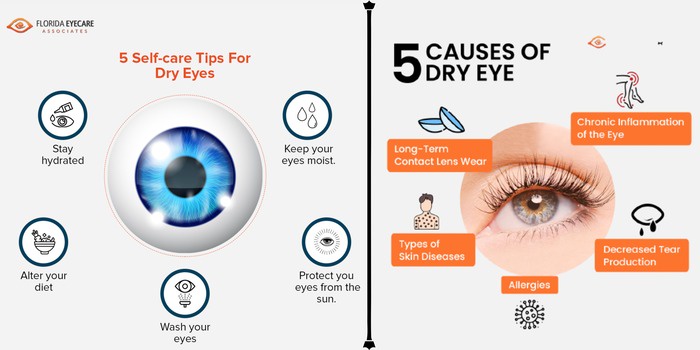Like other parts of the body, our eyes are also a very important aspect. In simple words, one of our most important senses is a vision as 80% of what we perceive comes through our sense of sight. By taking care of your eyes, we will lower the risk of becoming blind and losing our vision while also keeping an eye out for any eye conditions like glaucoma and cataracts that may be developing. If talking about eye problems or diseases, then dry eye disease that occurs in every tenth person. As per a recent study on Dry eye clinics, dry eye disease is more difficult to treat than previously believed.
Let’s dive in to learn more!!
What is Dry Eye?
It is an eye disease or a condition that occurs when your tears aren’t able to provide adequate lubrication for your eyes.
Or
In simple terms, our eyes need tears to stay healthy and comfortable. If your eyes do not produce enough tears, it is called dry eyes. Yes, tears form a film that covers the eye when we blink. This maintains the eye’s clear and smooth surface. For clear vision, the tear film is crucial.
The Tear Film is Made of Three Layers and Plays a Special Role:
- a greasy layer: The meibomian glands in the eye produce this layer that smooths out the tear surface and slows down the rate of drying.
- a layer of water: This middle layer comes from the lacrimal glands in the eyelids. It removes debris that shouldn’t be in the eye from the eye and cleans the eye.
- a layer of mucus: It is an inner layer produced in the conjunctiva that clear tissue covering the white of your eye and inside your eyelids.
Common Causes of Dry Eye:
Common causes of decreased tear production or dry eye include:
- Aging
- Sjogren’s syndrome,
- allergic eye disease,
- rheumatoid arthritis,
- lupus,
- scleroderma,
- graft vs. host disease, sarcoidosis,
- thyroid disorders or vitamin A deficiency.
- Long screen time,
- Less eye blinking,
- Dehydration, etc.
Symptoms of Dry Eye:
- Scratchy sensation in eyes
- Eye stringy mucus in or around
- Responsiveness to light
- A reddened eye
- A feeling that something is in your eyes
- Wearing contact lenses is challenging
- Driving at night can be challenging.
- The body’s reaction to dry eyes’ irritability is watery eyes.
- Vision haze or eye fatigue
Dry Eye Treatment Options:
As mentioned earlier that the treatment for dry eyes disease is more difficult to treat than previously believed. In just a few short years, treatment has advanced significantly, and there are now more options than ever. A few of them are listed below:
- Eye Drops: It is one of the best treatments for dry eye. Eye drops are also known as artificial tears. And the best part is that you can get these drops without a prescription (If you are not prawned to any other health problem) They may help your eyes feel better.
- Prescription Medicine: Your eye doctor might prescribe you cyclosporine (Restasis) or lifitegrast if your dry eye condition is more severe (Xiidra). Both of these medications are eye drops that can encourage your eyes to produce more tears.
- Lifestyle Changes: Sometimes, doctors suggest changes to help protect your eyes. It may include:
- Avoid smoking.
- Say no to long screen time or take frequent breaks.
- When outside, put on a pair of sunglasses with a rim.
- Try to drink 8 to 10 glasses of water per day.
- Get between 7 and 8 hours of sleep each night.
Conclusion:
This is it! We hope this guide will help you to learn about dry eyes more briefly. If you or your any of family members facing such issues and seeking for reliable dry eye clinic to offer to get possible treatments, then Florida Eyecare Associates is advanced eye care and cosmetic center known for providing you with the best eye care services. To know more, browse their website!
FAQ’s
How much time does dry eye last?
A dry eye may be permanent or only last a few hours to several months. When the condition and its symptoms persist for days, weeks, or months, it is said to be chronic dry eye.
Does having dry eyes hurt?
Eye pain is undoubtedly a sign of the dry eye, even though other symptoms are more frequent. Dry eye discomfort may manifest as mild, severe eye pain or more frequent stinging, a gritty feeling, or a dull ache.
Does crying relieve dry eyes?
Yes, when we cry, endorphins are released from our eyes. It is a type of chemical that is produced by our brain to promote feelings of well-being. Tears also help maintain eye health and help ward off dry eye disease and a higher risk of infection.
What happens if you leave dry eyes untreated?
It may lead to eye inflammation, abrasion of the corneal surface, corneal ulcers, and vision loss. Sometimes, it decreases the quality of life.


No comments yet